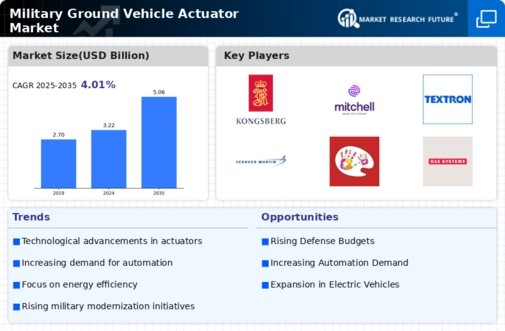Geopolitical Tensions
Geopolitical tensions across various regions are influencing the Global Military Ground Vehicle Actuator Market Industry. Heightened security concerns prompt nations to bolster their military capabilities, leading to increased procurement of advanced ground vehicles equipped with state-of-the-art actuators. For example, ongoing conflicts and territorial disputes in regions such as Eastern Europe and the South China Sea have resulted in accelerated defense spending. This environment is likely to sustain market growth, with projections indicating a compound annual growth rate of 4.2% from 2025 to 2035. Such dynamics highlight the critical role of actuators in enhancing military readiness.
Increased Defense Budgets
The Global Military Ground Vehicle Actuator Market Industry is experiencing growth due to increased defense budgets across various nations. Countries are allocating more resources to modernize their military capabilities, which includes upgrading ground vehicles with advanced actuators. For instance, the United States has proposed a defense budget of 842 billion USD for 2024, reflecting a commitment to enhance military readiness. This trend is mirrored in other nations, leading to a projected market value of 3.22 billion USD in 2024, with expectations to reach 5.06 billion USD by 2035. Such investments are likely to drive demand for sophisticated actuator systems.
Market Growth Projections
The Global Military Ground Vehicle Actuator Market Industry is poised for substantial growth, with projections indicating a market value of 3.22 billion USD in 2024 and an anticipated increase to 5.06 billion USD by 2035. This growth trajectory reflects a compound annual growth rate of 4.2% from 2025 to 2035, driven by factors such as increased defense budgets, technological advancements, and rising demand for autonomous vehicles. The market's expansion is indicative of the evolving landscape of military operations, where advanced actuator systems are becoming integral to enhancing the capabilities of ground vehicles.
Technological Advancements
Technological advancements play a crucial role in shaping the Global Military Ground Vehicle Actuator Market Industry. Innovations in actuator technology, such as the development of electric and hybrid systems, enhance vehicle performance and efficiency. For example, the integration of smart actuators allows for improved control and responsiveness in military operations. As these technologies evolve, they are expected to contribute to a compound annual growth rate of 4.2% from 2025 to 2035. This growth indicates a shift towards more sophisticated systems that can adapt to the dynamic requirements of modern warfare.
Focus on Modernization Programs
Modernization programs within military organizations are driving the Global Military Ground Vehicle Actuator Market Industry. Many countries are undertaking extensive upgrades of their existing fleets to enhance performance and extend service life. For instance, nations are investing in retrofitting older vehicles with advanced actuator systems to improve maneuverability and combat effectiveness. This focus on modernization is expected to contribute to a market value of 5.06 billion USD by 2035, reflecting the ongoing commitment to maintaining a competitive edge in military capabilities. Such initiatives underscore the importance of integrating cutting-edge technology into ground vehicle systems.
Rising Demand for Autonomous Vehicles
The rise of autonomous military vehicles is significantly influencing the Global Military Ground Vehicle Actuator Market Industry. As militaries explore unmanned ground vehicles for reconnaissance and combat roles, the need for reliable and efficient actuators becomes paramount. These systems are essential for enabling precise movements and operational capabilities in challenging environments. The increasing focus on automation is likely to propel market growth, with projections indicating a market value of 3.22 billion USD in 2024. This trend aligns with broader defense strategies that prioritize technological superiority and operational efficiency.











